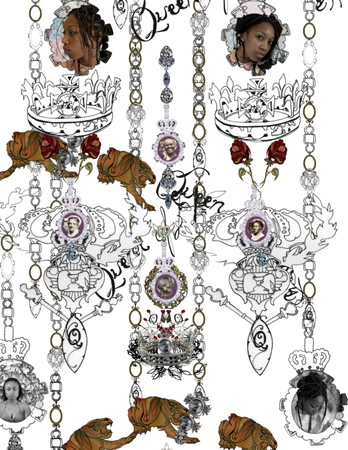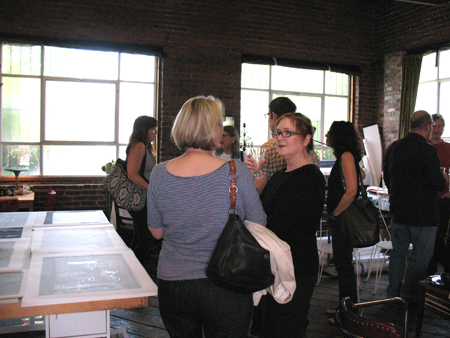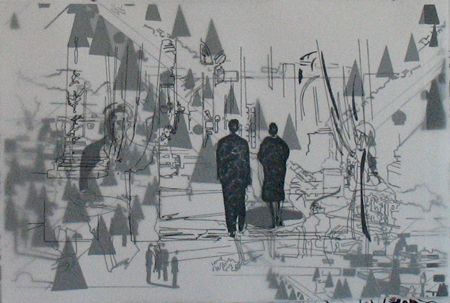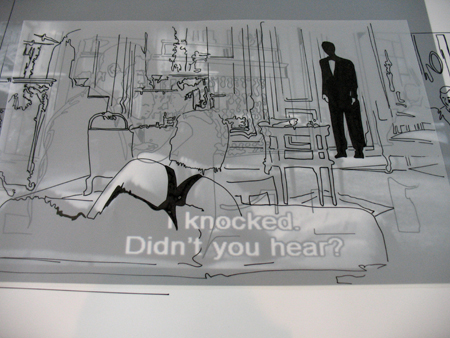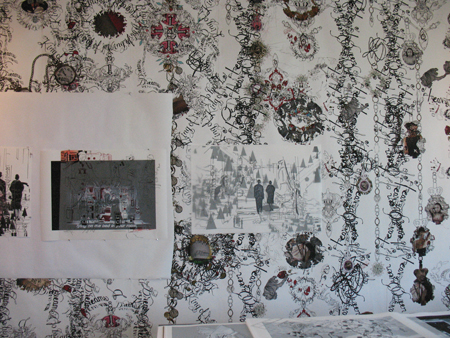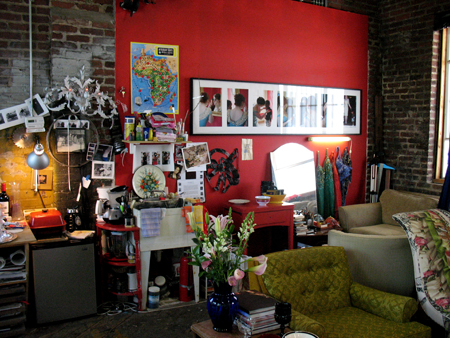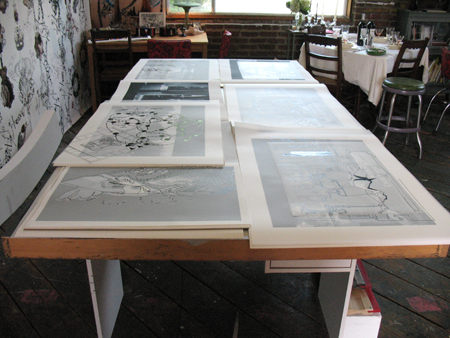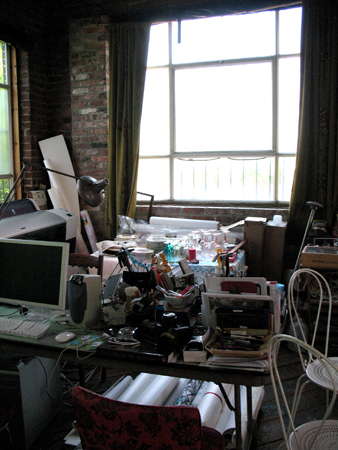This past Saturday was jam packed with artists’ talks, a panel discussion on painting in the morning (more on that in the next post), and another Seek ATL studio visit and dialogue with artist Nancy VanDevender, who has a space over at Atlanta Contemporary Art Center (ACAC). She teaches at Clark University.
VanDevender uses video, photography, pattern and typography and in this new work, she’s drawing. She is also interested in space and installation, what she calls sets and salons. Large scale color photographs include women with intricate tatoos; the body as subject. She has created Victoriana and heraldic patterned wallpaper with African American women’s faces cut and pasted into it, with historical references that include the Civil Rights movement. Her take on feminism and ritual has juxtaposed young African American women posed in bathing suits before a backdrop wallpaper of ruffles and maps.
In her current work in progress, she is appropriating and layering frames from three films; the always fascinating Alain Resnais’s Last Year at Marienbad, Lars Van Triers’ Dogville and Hong Kong based Wong Kar-Wai’s retro and beautifully dysfunctional In the Mood for Love. This series is still being worked on, but VanDevender suggests that she wants to lead the viewer into the idea of game playing and show the alienation that can occur through the formation of cliques.
To take one film example, Marienbad  deals with memory and the loss of continuity over time. The film’s baroque hotel set and formal gardens are obvious in the patterns that VanDevender works into her layered assemblages. Self-trickery in this film is not so much a game but a question. What is reality, what is memory but a series of constructs?
The Seek group, including ACAC’s Stuart Horodner at this visit, discussed how the artist’s intent might be further elaborated. The complexity of the layering and perspective created by patterned repetition is what makes these tableaus so interesting. The artist’s main focus seems to be people; how they relate to each other, their roles in society, and race and gender issues.
That mystery is a feature of all three of the films seems to carry over as an element into VanDevender’s work. Like Resnais, she does not want to so much portray a linear narrative, as to look at an entire scene at once and highlight the reference points of the filmic ‘armature’. She says her interest is in how people meet, and the circumstances in which some random meetings take place.
Nancy’s statement on her site notes that “she is an installation artist who uses space as a platform for mixing politics, theatre, and design. Through a sculptural practice, physical ornamentation and digital illusion are handled as both flattened historical venue and projected politicized stage. The collection, alteration, and arrangement of tattoos provide interior displays of presumed relationships and shared cultures.”
VanDevender’s new work prompts a rumination on figurative art and mark-making. What is the signatory pattern to these pieces? The combination of  iconography that she mines results in dense overlapped perspectives. Are the patterns a decorative ruse meant to confound, which then become an analogy for the way that the participants in the films struggle to meet and interact?
David Cope, a UC Santa Cruz Professor Emeritus of Music embarked on a project when he suffered from composer’s block. He used a computer scientist’s help to develop a program that could reveal musical patterns; the DNA of the composer’s ‘mark-making’. In his words:
“Recombinancy can be defined simply as a method for producing new music by recombining extant music into new logical successions…recombinancy appears everywhere as a natural evolutionary and creative process. All the great books in the English language, for example, are constructed from recombinations of the twenty-six letters of the alphabet.
Similarly, most of the great works of Western art music exist as recombinations of the twelve pitches of the equal-tempered scale and their octave equivalents. The secret lies not in the invention of new letters or notes but in the subtlety and elegance of their recombination.”
In these appropriated frames, the artist recombines icons and symbolism to explore gender roles, isolation and relationships. We look forward to seeing the elegance of her results.
Thanks again to Shara and Ben from Seek ATL for organizing these studio visits for local artists, in which to engage, connect and discuss.

